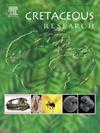Vegetation and climate during the primary formation of the Songliao Basin, NE China
IF 1.7
3区 地球科学
Q1 GEOLOGY
引用次数: 0
Abstract
The International Continental Scientific Drilling Project (ICDP) in the Songliao Basin that has produced a continuous core of the Lower Cretaceous in 4134.81 m thickness, i.e. the SK-II borehole, provides an exceptional archive for studying tectonic and palaeoenvironmental history of the basin under the Cretaceous greenhouse climate. The Shahezi Formation that consists of the main part of this core, represents the primary basin fills at the syn-rift stage of the Songliao Basin and thus marks its commencement and is crucial for studying the timing and mechanism of this basin's early evolution. The precise age of the Shahezi Formation, however, remains controversial and little is known about the palaeovegetation and palaeoenvironment during its deposition. In this study, plenty of pollen and spores are extracted from core samples near the base of the Shahezi Formation. They are the oldest fossils so-far identified from the SK-Ⅱ borehole. The high abundance and diversity of Cicatricosisporites, in association with some other fossils as Pilosisporites, indicate a clear early–middle Aptian age for the base of the Shahezi Formation, i.e. the primary formation of the Songliao Basin. The vegetation was overall featured by abundant ferns, common cycads and some bryophytes in the ground storey, alongside conifer trees or shrubs of Pinaceae, Taxodiaceae, Araucariaceae and Cheirolepidiaceae in the upper canopy, with increases of Cheirolepidiaceae and cycads over time. A generally warm and humid tropical to subtropical climate with a trend to be slightly drier was developed, which might be a response of terrestrial ecosystem to the Oceanic Anoxic Event 1a.
松辽盆地初生期的植被与气候
国际大陆科学钻探项目(ICDP)在松辽盆地取得了厚度为4134.81 m的下白垩统连续岩心SK-II钻孔,为研究该盆地在白垩系温室气候下的构造和古环境史提供了一个独特的档案。该岩心的主体沙河子组代表了松辽盆地同裂谷期的主要盆地充填,标志着松辽盆地的开始,对研究松辽盆地早期演化的时间和机制具有重要意义。然而,沙河子组的确切年代仍有争议,对其沉积时期的古植被和古环境知之甚少。本研究从沙河子组底部附近的岩心样品中提取了大量的花粉和孢子。它们是迄今为止在SK-Ⅱ钻孔中发现的最古老的化石。cicatricosporites的高丰度和多样性,与其他一些化石(如Pilosisporites)相结合,表明松辽盆地沙河子组基底明显处于早-中阿普tian时代,即原始地层。植被总体上以地面层丰富的蕨类植物、普通苏铁和部分苔藓植物为特征,上层林冠层有松科、红杉科、云杉科和铁杉科的针叶乔木或灌木,随着时间的推移,铁杉科和铁杉科的数量有所增加。形成了温暖湿润的热带—亚热带气候,并有偏干燥的趋势,这可能是陆地生态系统对海洋缺氧事件1a的响应。
本文章由计算机程序翻译,如有差异,请以英文原文为准。
求助全文
约1分钟内获得全文
求助全文
来源期刊

Cretaceous Research
地学-地质学
CiteScore
4.10
自引率
19.00%
发文量
235
审稿时长
12 weeks
期刊介绍:
Cretaceous Research provides a forum for the rapid publication of research on all aspects of the Cretaceous Period, including its boundaries with the Jurassic and Palaeogene. Authoritative papers reporting detailed investigations of Cretaceous stratigraphy and palaeontology, studies of regional geology, and reviews of recently published books are complemented by short communications of significant new findings.
Papers submitted to Cretaceous Research should place the research in a broad context, with emphasis placed towards our better understanding of the Cretaceous, that are therefore of interest to the diverse, international readership of the journal. Full length papers that focus solely on a local theme or area will not be accepted for publication; authors of short communications are encouraged to discuss how their findings are of relevance to the Cretaceous on a broad scale.
Research Areas include:
• Regional geology
• Stratigraphy and palaeontology
• Palaeobiology
• Palaeobiogeography
• Palaeoceanography
• Palaeoclimatology
• Evolutionary Palaeoecology
• Geochronology
• Global events.
 求助内容:
求助内容: 应助结果提醒方式:
应助结果提醒方式:


